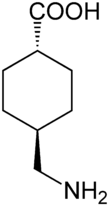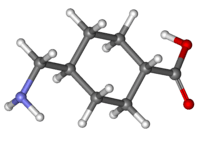Tranexamic acid
 | |
 | |
| Systematic (IUPAC) name | |
|---|---|
| trans-4-(aminomethyl)cyclohexanecarboxylic acid | |
| Clinical data | |
| AHFS/Drugs.com | Consumer Drug Information |
| |
| |
| Injection and oral | |
| Pharmacokinetic data | |
| Bioavailability | 34% |
| Half-life | 3.1 h |
| Identifiers | |
|
1197-18-8 | |
| B02AA02 | |
| PubChem | CID 5526 |
| DrugBank |
DB00302 |
| ChemSpider |
10482000 |
| UNII |
6T84R30KC1 |
| KEGG |
D01136 |
| ChEBI |
CHEBI:48669 |
| ChEMBL |
CHEMBL877 |
| Chemical data | |
| Formula | C8H15NO2 |
| 157.21 g/mol | |
|
SMILES
| |
| |
| | |
Tranexamic acid (\ˌtran-eks-ˌam-ik-\) is a synthetic analog of the amino acid lysine. It is used to treat or prevent excessive blood loss during surgery and in various medical conditions or disorders (helping hemostasis). It is an antifibrinolytic that competitively inhibits the activation of plasminogen to plasmin, by binding to specific sites of both plasminogen and plasmin, a molecule responsible for the degradation of fibrin, a protein that forms the framework of blood clots. Tranexamic acid has roughly eight times the antifibrinolytic activity of an older analogue, ε-aminocaproic acid.
Medical uses
Tranexamic acid is frequently used in surgeries with high risk of blood loss such as heart, liver, vascular and large orthopedic procedures. Its oral form is now being evaluated for use in outpatient conditions involving heavy bleeding.
Trauma
Tranexamic acid has been found to decrease the risk of death in people who have significant bleeding due to trauma.[1][2] However, its benefit only appears to be within the first three hours.[3]
Heart surgery
Tranexamic acid is commonly used in cardiac surgery, both with and without cardiopulmonary bypass. It replaces aprotinin.
Orthopedic surgery
Tranexamic acid is used in orthopedic surgery to reduce blood loss, to the extent of reducing or altogether abolishing the need for perioperative blood collection . It is of proven value in clearing the field of surgery and reducing pre- and postoperative blood loss. Drain and number of transfusions are reduced. However, the hidden blood loss is not reduced. Still, it is becoming an important tool in the anaesthetist's arsenal. It is commonly used in joint replacement surgery.
Craniofacial surgery
Use of tranexamic acid in surgical corrections of craniosynostosis in children reduces the need for blood transfusions.[4]
Menstrual bleeding
Used as firstline nonhormonal treatment of dysfunctional uterine bleeding, and heavy bleeding associated with uterine fibroids. An August 2007 study showed patients treated with tranexamic acid are more likely to develop thrombosis and necrosis in their fibroids, and may result in pain and fever.[5] The histological appearance of the necrosis in women treated by tranexamic acid is no different from the spontaneous incidence of thrombosis. The U.S. Food and Drug Administration (FDA) approved tranexamic acid oral tablets (brand name Lysteda) for treatment of heavy menstrual bleeding on 13 November 2009.
In March 2011 the status of Tranexamic acid for treatment of heavy menstrual bleeding (menorrhagia) was changed in the UK, from PoM (Prescription only Medicines) to P (Pharmacy Medicines)[6] and became available over the counter in UK pharmacies under the brand names of Cyklo-F and Femstrual, initially exclusively for Boots pharmacy, which has sparked some discussion about availability.[7] (In parts of Europe - like Sweden - it had then been available OTC for over a decade.) Regular liver function tests are recommended when using tranexamic acid over a long period of time.[8]
Dentistry
Tranexamic acid is used in dentistry in the form of a 5% mouth rinse after extractions or surgery in patients with prolonged bleeding time, e.g. from acquired or inherited disorders.
Other uses
- In obstetrics, tranexamic acid is used after delivery to reduce bleeding, often with syntocinon/oxytocin and fundal massage. A major trial is in progress worldwide to establish the efficacy of the drug to arrest postpartum haemorrhage (PPH). Since the drug can be administered orally, it has great potential to reduce maternal mortality rates in developing countries where primary healthcare is often unavailable.
- In cardiac surgery, e.g. coronary artery bypass surgery, it is used to prevent excessive blood loss.
- In spine surgery, e.g. scoliosis correction with posterior spinal fusion using instrumentation, to prevent excessive blood loss. [9]
- In hemophilia - Tranexamic acid is also useful in the treatment of bleeding as a second line treatment after factor VIII in patients (e.g. tooth extraction).
- In hereditary angioedema[10]
- In hereditary hemorrhagic telangiectasia - Tranexamic acid has been shown to reduce frequency of epistaxis in patients suffering severe and frequent nosebleed episodes from hereditary hemorrhagic telangiectasia.[11]
- In melasma - Tranexamic acid has shown to provide rapid and sustained lightening in melasma by decreasing melanogenesis in epidermal melanocytes.[12]
- In hyphema - Tranexamic acid has been shown to be effective in reducing risk of secondary hemorrhage outcomes in patients with traumatic hyphema.[13]
Adverse effects
Rare in general, including gastrointestinal effects, dizziness, fatigue, headache, and hypersensitivity reactions. Use of tranexamic acid has a potential risk of thrombosis.[4]
Society and culture
TXA has been included in the WHO list of essential medicines.[14] TXA is inexpensive and treatment would be considered highly cost effective in high, middle and low income countries.[15]
Brand names
Tranexamic acid is marketed in the U.S. and Australia in tablet form as Lysteda and in IV form as Cyklokapron and Transamin, in the UK as Cyclo-F and Femstrual, in Asia as Transcam, in Bangladesh as Traxyl, in South America as Espercil, in Japan as Nicolda, in France and Romania as Exacyl and in Egypt as Kapron.In the Philippines, its capsule form is marketed as Hemostan.
References
- ↑ http://www.upmc.com/media/NewsReleases/2014/Pages/pitt-trauma-experts-aim-reduce-deaths-providing-blood-clotting-agent-medical-helicopters.aspx[]
- ↑ Cherkas, David (Nov 2011). "Traumatic Hemorrhagic Shock: Advances In Fluid Management". Emergency Medicine Practice 13 (11).
- ↑ Napolitano, Lena M.; Cohen, Mitchell J.; Cotton, Bryan A.; Schreiber, Martin A.; Moore, Ernest E. (2013). "Tranexamic acid in trauma". Journal of Trauma and Acute Care Surgery 74 (6). doi:10.1097/TA.0b013e318292cc54. PMID 23694890.
- ↑ 4.0 4.1 RCPCH. "Evidence Statement Major trauma and the use of tranexamic acid in children Nov 2012". Retrieved 17 December 2012.
- ↑ Ip, Philip P. C.; Lam, Ka-Wai; Cheung, Ching-Lung; Yeung, Matthew C. W.; Pun, Ting-Chung; Chan, Queeny K. Y.; Cheung, Annie N. Y. (2007). "Tranexamic Acid-associated Necrosis and Intralesional Thrombosis of Uterine Leiomyomas". The American Journal of Surgical Pathology 31 (8). doi:10.1097/PAS.0b013e318032125e. PMID 17667546.
- ↑ Tranexamic Acid to be available OtC
- ↑ In defence of multiple pharmacies
- ↑ Allen, Helen (June 13, 2012). "Tranexamic acid for bleeding". Patient UK.
- ↑ Sethna, N. F.; Zurakowski, D; Brustowicz, R. M.; Bacsik, J; Sullivan, L. J.; Shapiro, F (2005). "Tranexamic acid reduces intraoperative blood loss in pediatric patients undergoing scoliosis surgery". Anesthesiology 102 (4): 727–32. PMID 15791100.
- ↑ Rod Flower; Humphrey P. Rang; Maureen M. Dale; Ritter, James M. (2007). Rang & Dale's pharmacology. Edinburgh: Churchill Livingstone. ISBN 0-443-06911-5.
- ↑ Klepfish, A; Berrebi, A; Schattner, A (2001). "Intranasal tranexamic acid treatment for severe epistaxis in hereditary hemorrhagic telangiectasia". Archives of internal medicine 161 (5): 767. PMID 11231712.
- ↑ Karn, D; Kc, S; Amatya, A; Razouria, E. A.; Timalsina, M (2012). "Oral tranexamic acid for the treatment of melasma". Kathmandu University Medical Journal 10 (40): 40–3. PMID 23575051.
- ↑ Gharaibeh, Almutez; Savage, Howard I; Scherer, Roberta W; Goldberg, Morton F; Lindsley, Kristina (2011). "Medical interventions for traumatic hyphema". Cochrane Database of Systematic Reviews (1): CD005431. doi:10.1002/14651858.CD005431.pub2. PMC 3437611. PMID 21249670.
- ↑ WHO. "Summary of the report of the 18th meeting of the WHO Expert Committee on the Selection and Use of Essential Medicines".
- ↑ Guerriero, Carla; Cairns, John; Perel, Pablo; Shakur, Haleema; Roberts, Ian; Crash 2 Trial, Collaborators (2011). "Cost-Effectiveness Analysis of Administering Tranexamic Acid to Bleeding Trauma Patients Using Evidence from the CRASH-2 Trial". PLoS ONE 6 (5). Bibcode:2011PLoSO...618987G. doi:10.1371/journal.pone.0018987. PMC 3086904. PMID 21559279.
External links
- (PoM to P in the UK)
- CRASH-2: tranexamic acid and trauma patients
- Patient Experience with tranexamic acid
- Tranexamic acid, UK patient information leaflet
- Effects of tranexamic acid on death, vascular occlusive events, and blood transfusion in trauma patients with significant haemorrhage (CRASH-2): a randomised, placebo-controlled trial (The Lancet)
- Drug will save lives of accident victims, says study, BBC News
- Types of Angioedema and treatments, Hereditary Angioedema Association
| ||||||||||||||||||||||||||||||||||||||||||||